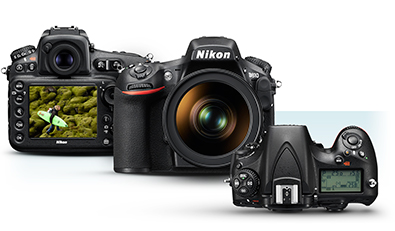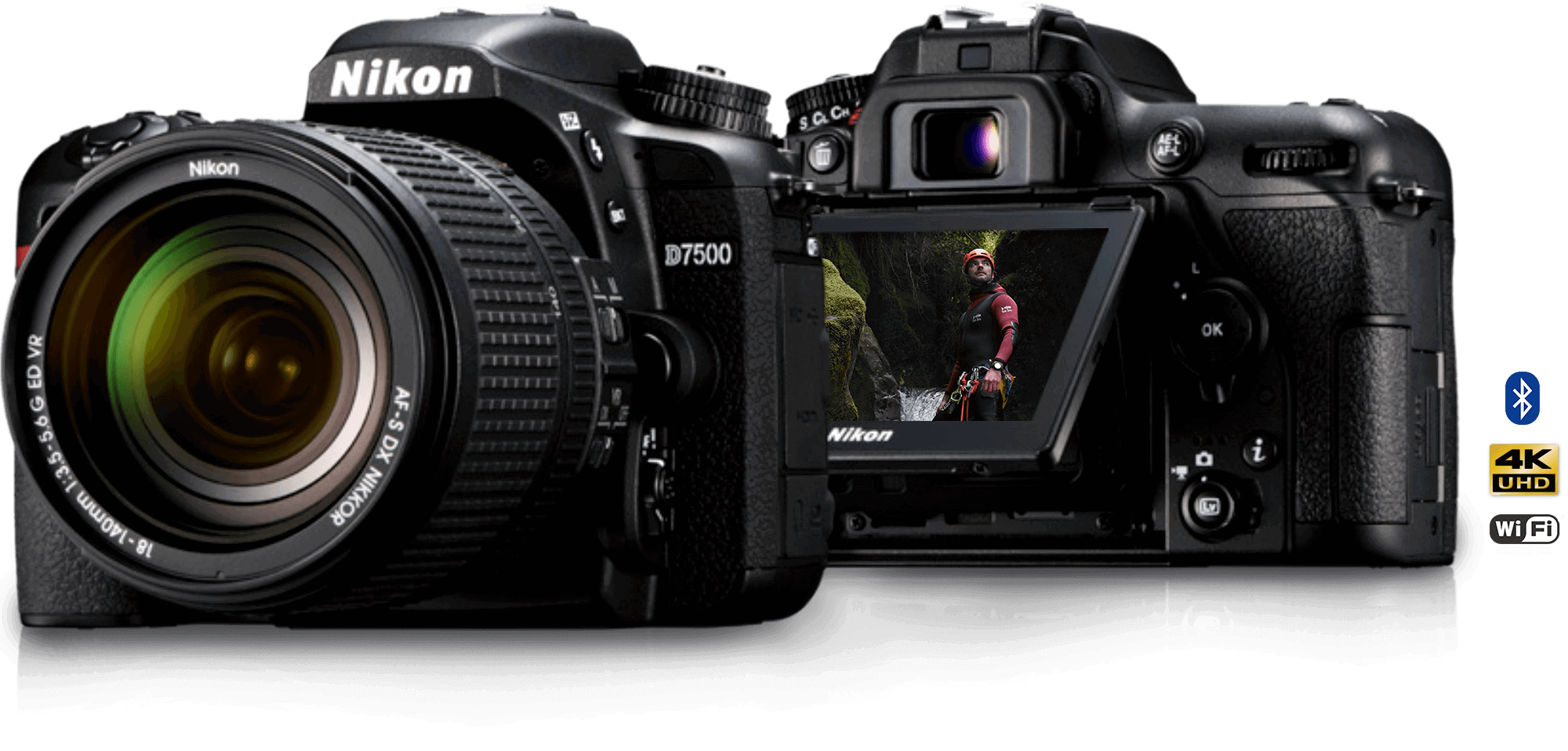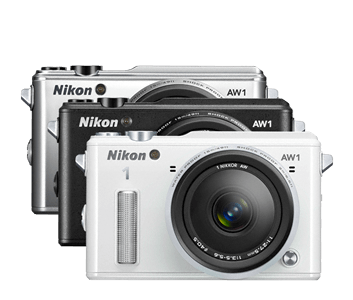Nikon Camera Comparison
Regardless of what type of photographer you are, Nikon likely has the right device for you. There are a ton of models to choose from, which is why we have compared all the major models available. We will let you know the essential specs and features of each camera, as well as which ones are best depending on your requirements and your budget.
Professional-Level Cameras for Dedicated Photographers

The following cameras are Nikon’s top models. They all come equipped with a full-frame CMOS sensor, which allows users to capture professional-quality images. If you are a passionate photographer who is after the best performance, then one of these devices may be perfect for you.
| Model | Image Processor | Megapixels | ISO Range | AF Points | Burst mode (fps) | Video | Display (Size and Resolution) | Touch Screen (Fixed or Rotating) | Approx. Price |
|---|---|---|---|---|---|---|---|---|---|
| D4 | EXPEED 3 | 16.2 | 100 – 12800 | 51 | 10 | 1080 30fps 720 60fps | 3.2″ 921k | No | $5,500 |
| D4S | EXPEED 4 | 16.2 | 100 – 12800 | 51 | 11 | 1080p 60fps 720p 60fps | 3.2″ 921k | No | $6,100 |
| D5 | EXPEED 5 | 20.8 | 100 -102400 | 153 | 12 | 4K 30fps 1080p 60fps | 3.2″ 2539k | Fixed | $6,500 |
| D600 | EXPEED 3 | 24.3 | 100 – 6400 | 39 | 5.5 | 1080 30fps 720p 60fps | 3.2″ 921k | No | $1,500 |
| D610 | EXPEED 3 | 24.3 | 100 – 6400 | 39 | 6 | 1080 30fps 720p 60fps | 3.2″ 921k | No | $1,500 |
| D750 | EXPEED 4 | 24.3 | 100 – 12800 | 51 | 6.5 | 1080p 60fps | 3.2″ 1229k | No | $1,800 |
| D800 | EXPEED 3 | 36.3 | 100 – 6400 | 51 | 4 | 1080p 60fps | 3.2″ 921k | No | $2,240 |
| D810 | EXPEED 4 | 36.3 | 64 – 12800 | 51 | 5 | 1080p 60fps | 3.2″ 1229k | No | $2,800 |
| D850 | EXPEED 5 | 45.7 | 64 – 25600 | 153 | 7 | 4K 30fps 1080p 120fps | 3.2″ 2539k | Rotating | $3,300 |
Mid-Range Models For Photography Enthusiasts

This selection of cameras incorporates APS-C sensors. While not as large as their full-frame counterparts, they are still up to the task of capturing high-quality imagery. If you want a powerful device with a more affordable price tag, then consider the options below.
| Model | Image Processor | Megapixels | ISO Range | AF Points | Burst mode (fps) | Video | Display (Size and Resolution) | Touch Screen (Fixed or Rotating) | Approx. Price |
|---|---|---|---|---|---|---|---|---|---|
| D500 | EXPEED 5 | 20.9 | 100 -51200 | 153 | 10 | 4K 30fps 1080p 60fps | 3.2″ 2359k | Rotating | $1,900 |
| D7100 | EXPEED 3 | 24.1 | 100 -6400 | 51 | 6 | 1080p 60fps | 3.2″ 1229k | No | $725 |
| D7200 | EXPEED 4 | 24.2 | 100 -25600 | 51 | 6 | 1080p 60fps | 3.2″ 1229k | No | $1,000 |
| D7500 | EXPEED 5 | 20.9 | 100 51200 | 51 | 8 | 4K 30fps 1080p 60fps | 3.2″ 922k | Rotating | $1,250 |
| D5100 | EXPEED 2 | 16.1 | 100 – 6400 | 11 | 4 | 1080p 30fps 720p 30fps | 3.0″ 921k | No | $444 |
| D5200 | EXPEED 3 | 24.1 | 100 – 6400 | 39 | 5 | 1080p 60fps 720p 60fps | 3.0″ 921k | No | $600 |
| D5300 | EXPEED 4 | 24.1 | 100 – 12800 | 39 | 5 | 1080p 60fps 720p 60fps | 3.2″ 1037k | No | $555 |
| D5500 | EXPEED 4 | 24.1 | 100 – 25600 | 39 | 5 | 1080p 60fps 720p 60fps | 3.2″ 1037k | Rotating | $640 |
| D5600 | EXPEED 4 | 24.2 | 100 – 25600 | 39 | 5 | 1080p 60fps 720p 60fps | 3.2″ 1037k | Rotating | $790 |
| D3200 | EXPEED 3 | 24.2 | 100 – 6400 | 11 | 4 | 1080p 30fps | 3.0″ 921k | No | $300 |
| D3300 | EXPEED 4 | 24.2 | 100 – 12800 | 11 | 5 | 1080p 60fps | 3.0″ 921k | No | $400 |
| D3400 | EXPEED 4 | 24.2 | 100 -25600 | 11 | 5 | 1080p 60fps | 3.0″ 921k | No | $500 |
Basic Cameras for Entry-Level Photographers

If you don’t need the latest piece of tech but just want a simple to use device that takes nice photos, then you may want to consider one of Nikon’s more compact cameras. These cameras typically have sensor sizes of 1” or 1/2.3”. While these may be small, they still pack a punch and make for a more affordable price tag.
| Model | Image Processor | Megapixels | ISO Range | AF Points | Burst mode (fps) | Video | Display (Size and Resolution) | Touch Screen (Fixed or Rotating) | Approx. Price |
|---|---|---|---|---|---|---|---|---|---|
| AW1 | EXPEED 3A | 14.20 | 160 – 6400 | 73 | NA | 1080p 60fps 720p 60fps | 3.0” 921k | No | $800 |
| A300 | NA | 20.1 | 80 – 3200 | 99 | 1.1 | 720p 30fps | 2.7” 230k | No | $160 |
| A900 | NA | 20.2 | 80 – 1600 | 99 | 7 | 4K 30fps 1080p 60fps | 3.0” 921k | No | $264 |
| B500 | NA | 16.1 | 125 – 6400 | 99 | 7.4 | 1080p 60fps 720p 60fps | 3.0” 921k | No | $310 |
| B700 | NA | 20.2 | 100 – 1600 | NA | 5 | 4K 30fps 1080p 60fps | 3.0” 921k | No | $447 |
| P900 | NA | 16.1 | 100 – 6400 | NA | 7.1 | 1080p 60fps 720p 60fps | 3.0” 921k | No | $550 |
| W100 | NA | 13.2 | 125 – 1600 | NA | 4.7 | 1080p 30fps 480p 30fps | 2.7” 230k | No | $157 |
| W300 | NA | 16 | 125 – 1600 | 99 | 7 | 4K 30fps 1080p 60fps | 3.0” 921k | No | $340 |
Choosing a Sensor
When it comes to sensors, bigger is better. If you have ever seen on TV the cameras used by a Hollywood crew, you will notice that the sensors they use are massive. That’s because they are after the highest quality footage.
Professional-level cameras usually have full-frame sensors, which are the most expensive. A bit smaller are APS sensors. However, the smaller size also means the camera is more affordable. 1” and 1/1.2” sensors are common on cheaper entry-level cameras
You can see the list of different sensor sizes below. It starts at the biggest size and works its way downwards.
- Full Frame
- APS-H
- APS-C
- 5”
- 4/3”
- 1”
- 1/1.2”
- 2/3”
- 1/1.7”
- 1/2.3”
- 1/3.2”
You should also check a camera’s megapixel rating. While the size of the sensor is by far the most important, you shouldn’t forget about the number of pixels available. These pixels help build up the detail of an image and the more of them available, the better. Try and select a model with 20+ megapixels.
Image Processors
What your camera’s sensor sees isn’t necessarily what is shown in the final photo. Cameras have image processors which work hard to fix image errors (such as lighting problems) so that the final product looks better.
Of course, this is only true when shooting with JPEG or other processed formats. If you’re shooting RAW photos, then you will be getting exactly what your sensor sees, and it will be up to you to process it.
Most of Nikon’s cameras rely on EXPEED image processors. These come with version numbers: the higher, the better.
You may have noticed that there is no image processor information for most of our entry-level cameras. These cameras do still have image processors. However, Nikon has not released any information about the brand or model of these systems.
The Importance of ISO
If you intend to shoot in very bright or very dark conditions, then you will want to pay extra attention to a camera’s ISO range. ISO is simply a measurement of light sensitivity. The lower the number, the lower the light sensitivity, and vice versa.
For example, if you’re taking photos on a bright, sunny day and you use too high of an ISO setting, then you will end up with too much light in the final image. In fact, the photo may be so bright that all you end up with is a yellow blur. The same situation can happen if you use too low a setting when filming in dark conditions.
Burst Mode for Action Photography
If you’re going to be filming fast-moving subjects, such as sports players, wildlife, or moving vehicles, then you should pay attention to a camera’s burst capabilities. This reading will let you know the maximum amount of images a camera can take per second. The higher the number, the better, as you will end up with more options at the end.
If you plan on undertaking a lot of action photography then you should look for a camera with a burst of at least 5fps — 7 or 8fps is even better.
Autofocus Points
Most cameras have automatic autofocus systems, which make selecting your subject a breeze. Of course, you also have the option of doing so manually. Now, for autofocus to work effectively, you need a range of AF (autofocus) points available to help select a subject. The higher this number, the easier your camera’s autofocus will be to use. It will also make it easier to track subjects as they move from point to point.
Video Quality
The latest cameras can do more than snap photos: they can also record high-definition video (720p and 1080p). Some can even record in 4K which is ultra-high definition footage. If you do plan on making a lot of videos, then look for a camera which has a high video quality. You should also check the frame rates available.
For most people, 1080p will be high enough quality. However, if you do want to record in 4K, then you should keep some facts in mind. 4K is extremely data heavy. You will need a host of SD cards and hard drives to store the footage. You will also need a powerful computer to edit the footage. If you lack either of these, then you may be wasting your time by searching for a 4K camera.
Which Camera is Best for Professional Photographers?
If you after a top of the range model then it’s hard to beat the Nikon D5. A full-frame 20.8 megapixel camera will allow you to capture exquisite images. A 100 – 102,400 ISO range makes it easy to shoot in both bright and dark conditions. 153 AF points make it simple to hone in on your subject, while a 12fps burst is great for action photography. Users can also record 4K video at 30fps. Don’t forget that the device has a high-definition touchscreen. Of course, you are looking at a hefty price tag of about $6,500.
Photographers on more of a budget may want to consider the Nikon D850. This device only costs around $3,300, while still retaining a lot of the same features as the Nikon D5 — It has a full-frame sensor, 153 AF points, and can record 4K video. The ISO range isn’t quite as wide but still more than enough. The burst mode is also not as great but still effective for shooting fast-moving subjects. Users will also find the camera easy to operate due to its rotating touchscreen.
Which Camera is a Good Mixture of Power and Value?
Those seeking all-around value should consider an APS-C camera as they’re more affordable than their full-frame counterparts. A solid option is the Nikon D7500. This device has 20.9 megapixels and a high-end EXPEED 5 processor for capturing sharp images. 51 AF points make the device easy to use, and the 8fps burst is also handy for shooting moving targets. If you’re seeking extremely high-quality video footage, then this camera can record 4K at 30fps, as well as 1080p at 60fps. The D7500 costs approximately $1,250.
If you want to go even cheaper then consider the Nikon D3400 for about $500. This device has a 24-megapixel APS-C sensor, 11 AF points, and a 5fps burst. While it lacks 4K capabilities, it can still record 1080p at 60fps. It’s not as powerful as the D7500. However, at under half the price, it still offers great value.
Which is the Best Camera for Basic Photography?
The B700 is a medium sized camera that is the perfect fit for entry-level photographers. A 20-megapixel 1/2.3” sensor allows users to take crisp photos. A burst mode of 5fps is handy for shooting moving subjects. You can also record 4K video at 30fps and 1080p at 60fps. Typically, this camera goes for about $447.
Another excellent option is the A900. This device also has a 20-megapixel 1/2.3” sensor and can record 4K at 30fps and 1080p at 60fps. Its burst mode can hit 7fps, and it is also much more compact than the B700. This powerful little package only costs around $264.
Final Thoughts
Choosing a camera is a very personal decision, which is why we suggest that you spend the time comparing these charts to get an idea of which models are best for you. Don’t forget to consider our recommendations as they offer both power and value. By looking closely, you will find that there are cameras to meet anyone’s requirements, regardless of their photography abilities or their budget.

